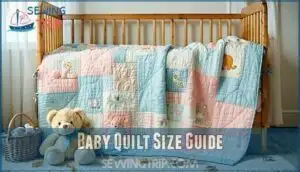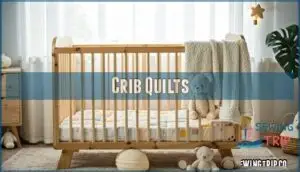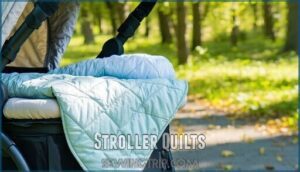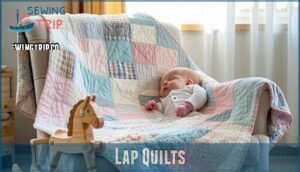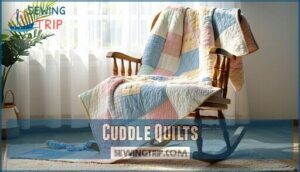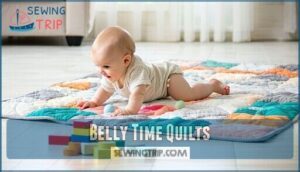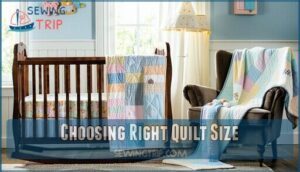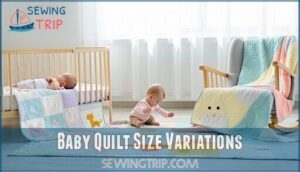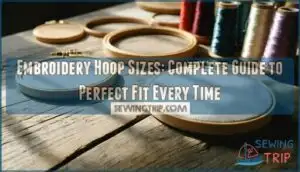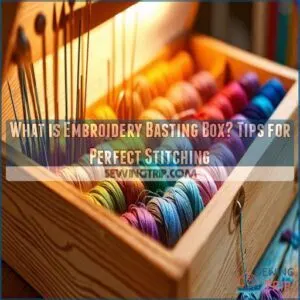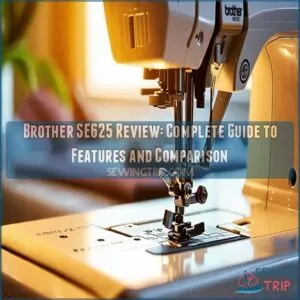This site is supported by our readers. We may earn a commission, at no cost to you, if you purchase through links.

The smallest is a receiving quilt at 30"×30", perfect for swaddling newborns. Crib quilts measure 36"×52" to fit standard cribs snugly.
For playtime, consider a 40"×60" play quilt that gives your little one room to wiggle. Toddler quilts run larger at 42"×68", growing with your child.
When choosing what size is a baby quilt for your needs, consider how long you’ll use it—many parents opt for slightly larger sizes to extend usage as babies grow quickly. Fabric needs vary too, with backing requiring an extra 6" on each side, and this is important for the baby’s comfort.
Table Of Contents
Key Takeaways
- You’ll find four standard baby quilt sizes: receiving quilts (30"×30") for newborns, crib quilts (36"×52") for standard cribs, play quilts (40"×60") for wiggle room, and toddler quilts (42"×68") that grow with your child.
- Consider how long you’ll use the quilt when choosing a size—slightly larger dimensions extend usage as babies grow quickly, while different quilt sizes serve specific purposes like stroller use, tummy time, or crib coverage.
- You’ll need extra fabric for backing (about 6" on each side) and batting (3-5" overhang), so plan your material requirements accordingly for proper finishing and quilting.
- For safety, avoid placing quilts in cribs with infants due to SIDS risk, and wait until your baby can move independently (around 6 months) before introducing quilts of appropriate sizes.
Baby Quilt Size Guide
You’ll find the perfect fit for your little one with baby quilts ranging from 30×30 inches for newborns to 36×52 inches for cribs.
Whether you’re making a snuggly first blanket or a lasting heirloom, choosing the right size guarantees your quilt will be both practical and treasured.
Choosing the perfect quilt size ensures your creation becomes a cozy treasure, blending practicality with heartfelt warmth for every stage of growth.
Standard Baby Quilt Sizes
A baby quilt’s size depends on its purpose, pattern, and who it’s for.
Luckily, there are standard dimensions to guide you:
- 30″ x 30″: Perfect for newborn cuddles.
- 30″ x 40″: A rectangular quilt option with extra length.
- 36″ x 52″: Crib mattress fit and ideal for bigger projects.
Choose these quilt dimensions for versatility and charm!
Age-Specific Quilt Sizes
Now that you know the standard sizes, let’s match quilt dimensions with your little one’s age.
As your baby grows, their quilt needs change too, which is a complete concept to consider when planning.
Remember to account for extra inches when planning your project, as batting sizes vary.
| Age Group | Size Range | Perfect For | Key Benefit | Best Shape |
|---|---|---|---|---|
| Newborn (0-3 months) | 30" x 40" | Cuddle time | Cozy security | Rectangle |
| Infant (3-12 months) | 35" square+ | Belly time | Growing movement | Square |
| Toddler (1-3 years) | 38" x 48" | Crib/play | Versatility | Rectangle |
| Preschool (3-6 years) | 40" x 50" | Nap time | Independence | Rectangle |
| Child (7+ years) | 48" x 60"+ | Bed covering | Long-lasting | Rectangle |
The provided table outlines the perfect sizes for different age groups, including Newborn, Infant, Toddler, Preschool, and Child, to ensure the quilt is long-lasting and provides cozy security.
Fabric and Batting Requirements
When planning your baby quilt, fabric requirements vary based on size.
For a 30" x 30" quilt, you’ll need one yard of backing fabric. Larger 36" x 52" crib quilts may require piecing the backing.
High-quality backing fabric is essential for durability.
Always allow for 3-5" batting overhang on all sides for easier quilting. Pre-cuts can simplify the process while different batting types offer varying warmth and loft for your little one’s comfort.
What Size is Baby Quilt
The classic baby quilt typically measures 30 x 30 inches for a square design, though you’ll find standard baby quilt dimensions vary widely.
Here’s a short, engaging blockquote in the same tone as the paragraph:
A perfect 30×30 inch square encompasses a world of love, though baby quilt dimensions dance to their own rhythm.
Most crib quilt sizes range from 30 x 40 inches to 36 x 52 inches, allowing for growth. Custom quilt designs often adjust these measurements by 4-8 inches based on pattern requirements.
Throughout quilt size history, dimensions have evolved to match changing cribs and safety standards. A key factor is mattress size considerations when planning your quilt.
When creating heirloom quilts or quilting for charity, remember that material impact matters—larger quilts require more fabric but offer longer use as your little one grows.
Quilt Size and Usage
You’ll find that matching your baby quilt’s size to its purpose makes all the difference in how useful it becomes.
Whether you’re making a 30" x 30" cuddle quilt for a newborn or a 36" x 52" crib quilt for a toddler, choosing the right dimensions guarantees your handmade creation serves its intended purpose perfectly.
Crib Quilts
When selecting crib quilts for your little one’s nursery, the standard dimensions are 40.5 inches wide by 49 inches long.
These cozy coverings offer four key benefits:
- Perfect fit for standard crib mattresses
- Breathable, lightweight construction for temperature regulation
- Versatile use beyond the crib for playtime activities
- Stylish addition to nursery décor while providing comfort
Remember that crib quilt safety always comes first, and it is essential for a nursery to have this in mind.
Stroller Quilts
Your on-the-go baby deserves the perfect stroller quilt. Standard stroller quilt dimensions typically range from 30 x 40 inches, though compact 22 x 30 inch options work well for smaller strollers.
Choose lightweight, breathable fabrics like polyester microfiber that machine wash easily. These versatile baby blankets can later double as play mats or cuddle quilts.
For maximum portability, look for quilts with simple wholecloth designs that fold easily into diaper bags. Stroller blankets often use muslin material properties for breathability.
Lap Quilts
Lap quilts offer the perfect middle ground between portable and functional for both babies and caregivers.
They typically measure 36" x 48" – just right for covering small legs during story time.
Here’s what makes lap quilts special:
- Versatile enough for car seats, nursing sessions, and quick naps
- Large enough to tuck around baby but small enough for one-handed management
- Perfect size for practicing your quilting techniques without overwhelming commitment
The size of lap quilts makes them ideal for practicing your skills without feeling overwhelmed by a large project.
Cuddle Quilts
Cuddle quilts offer the perfect size for snuggling with your newborn. These cozy blankets typically measure 30-40 inches, making them ideal for wrapping your baby in warmth without excess fabric getting in the way.
| Size | Best Use | Fabric Recommendation |
|---|---|---|
| 30"×30" | Newborn Comfort | Flannel or Minky |
| 30"×40" | Car Seat Cover | Cotton with Fleece Backing |
| 34"×34" | Gifting Ideas | Heirloom Quality Cotton |
| 36"×36" | Easy Washing | Pre-washed Cotton |
You’ll love how these baby quilt dimensions balance practicality with snuggle-factor! They provide a great way to keep your baby warm and comfortable, making them an excellent choice for newborn comfort and easy washing.
Belly Time Quilts
Belly time gives your baby essential developmental opportunities, making a specialized quilt a must-have.
The ideal belly time quilt measures 35 inches square or larger, giving babies aged 3-12 months plenty of room to explore.
- Choose quilts with varying fabric textures (cotton, minky, flannel) for sensory stimulation
- Select thicker quilts with high-loft batting for extra cushioning
- Look for washable materials that can handle frequent cleaning after spit-ups
Choosing Right Quilt Size
You’ll find the perfect quilt size by matching it to your baby’s age and how you’ll use it.
Whether you need a 30" x 30" snuggle quilt for newborns or a 36" x 52" crib quilt that grows with your little one, choosing the right dimensions makes all the difference.
Safety Considerations
A baby’s safety comes first when choosing quilt sizes.
Never place quilts in cribs with infants due to SIDS risk and suffocation hazards.
Wait until your baby can move independently (around 6 months) before introducing quilts.
Even then, pick appropriate baby quilt sizes that won’t restrict movement, and always use safe materials.
Always use these guidelines and follow crib safety guidelines from the American Academy of Pediatrics to protect your little one.
Batting and Backing Requirements
Success in quilting often hinges on selecting the right batting and backing for your baby quilt.
You’ll need both materials to extend beyond your quilt top to guarantee proper finishing.
- Allow 3-5 inches of batting overhang on all sides for wiggle room during quilting
- For long-arm quilting, provide at least 4 inches of extra backing fabric
- Standard crib batting (45 x 60 inches) works well for most baby quilt dimensions
- Remember: proper fabric needs vary by quilt size, so measure twice!
Selecting the correct quilt batting is vital for comfort.
Personalization and Care
Your handmade treasure deserves special touches that make it truly one-of-a-kind.
Add personalization and follow proper care routines to guarantee your baby quilt lasts for generations.
When selecting fabric, consider options like soft cotton flannel for a gentle touch.
| Personalization | Care Method | Benefit |
|---|---|---|
| Quilt embroidery with baby’s name | Gentle washing with mild soap | Preserves colors and stitching |
| Safe dyes for custom patterns | Air-drying when possible | Maintains fabric integrity |
| Appliqué birth details | Storing flat in acid-free paper | Guarantees heirloom preservation |
Your baby quilt can become a lasting family heirloom with the right care and attention to detail, making it a truly unique gift.
Baby Quilt Size Variations
You’ll find baby quilts in several sizes from the classic 30 x 30 inch square to the roomy 36 x 52 inch crib fit, with shapes that can range from squares to circles.
Your choice will depend on how you plan to use the quilt, with smaller options perfect for newborns and larger sizes giving toddlers room to grow, making toddlers an important consideration.
Square and Rectangular Quilts
Square and rectangular quilts remain the most popular shapes for baby bedding.
Square designs typically measure 30"×30" or 36"×36", perfect for newborn quilt sizes. Rectangular quilts often follow dimensions like 30"×40" or 36"×52", providing more coverage for growing babies.
Your patchwork square designs and rectangular block layouts can influence border width effects—ultimately affecting the quilt’s proportions and aesthetics. Remember, baby quilt patterns work beautifully in either geometry.
Hexagon and Circular Quilts
While rectangular designs are popular, hexagon and circular quilts offer unique geometric appeal for your baby’s space.
Creating these Shape Variations requires precision:
- Use clear templates for consistent hexagon pieces
- Expect slight size differences when stitching circular hexagons
- Machine piecing provides better accuracy for complex Pattern Adaptations
- Customize dimensions based on your comfort with Piecing Challenges
Hexagon and circular Modern Designs work beautifully at standard baby quilt sizes but allow for creativity in how pieces come together. Many quilters find that pre-cut fabric sets simplify the process.
Larger Quilts for Older Children
As your children grow, their quilt needs evolve beyond the crib.
Twin, full, and queen sizes (42×50 to 50×60 inches) fit perfectly when upgrading to big kid beds.
A 50" square quilt is ideal for fort building and movie watching, while 72×72 inch throws work wonderfully as floor playmats or picnic blankets.
Many parents choose 100% organic cotton percale for these larger toddler quilts, offering comfort that lasts through all seasons.
Quilt Size and Intended Use
As your little one grows, your quilt needs will change too.
The perfect size depends entirely on how you’ll use it.
- Cuddle Quilt Size: 30" x 40" for snuggling newborns (0-3 months)
- Tummy Time Quilts: 35" square with thicker batting for comfort (3-12 months)
- Toddler Quilt Dimensions: 38" x 48" for active kids (1-3 years)
- Child Quilt Uses: 50" square or larger for big-kid beds (3+ years)
Many retailers offer a variety of cuddle quilt options for different ages and quilting needs.
Frequently Asked Questions (FAQs)
What is a standard baby quilt size?
Good things come in small packages!
Standard baby quilt sizes include 30"×30" squares for newborns, 30"×40" rectangles for infants, and 36"×52" for cribs.
You’ll find these dimensions provide perfect coverage as your little one grows, with small packages being ideal for them.
What is the best square size for a baby quilt?
For a square baby quilt, 30" x 30" works perfectly for newborns.
You’ll find this size ideal for swaddling and tummy time, while still being manageable to create.
Larger 36" squares accommodate growing babies nicely, and this can be considered a complete concept for baby quilt sizes.
What is the best type of fabric for a baby quilt?
You’d think synthetic materials would be best, but they’re not. Use 100% cotton for your baby’s quilt – it’s breathable, soft, washable, and won’t irritate sensitive skin. Pre-wash fabric before sewing.
How long does a baby quilt typically last?
A well-made baby quilt typically lasts 5-10 years with proper care. You’ll find it transforms from a nursery essential to a cherished keepsake that’ll withstand countless washes and childhood adventures.
What is the difference between a crib quilt and a baby quilt?
Crib quilts (36" x 52") fit standard crib mattresses, while baby quilts come in smaller sizes like 30" x 30" or 30" x 40". You’ll use crib quilts when your little one moves to a crib.
How often should a baby quilt be washed?
Keep your baby’s quilt as clean as a whistle by washing it every 1-2 weeks or immediately when soiled.
You’ll want to use mild detergent, gentle cycle, and low heat drying for best results.
What is the best way to store a baby quilt?
Store your baby quilt in an acid-free box or pillowcase to prevent yellowing.
You’ll want to avoid plastic bags which trap moisture.
Fold it loosely with acid-free tissue between layers for heirloom protection.
How often should baby quilts be washed?
Wash your baby’s quilt every 1-2 weeks with regular use, or immediately if soiled.
You’ll need more frequent washing during teething or illness.
Always follow the fabric care instructions for best results.
Can baby quilts be machine quilted?
Like a gentle hug, machine quilting cradles your baby’s quilt perfectly.
You can definitely use your sewing machine to quilt baby blankets, saving time while creating beautiful, durable stitches for your little one’s comfort.
What thread is best for baby quilts?
Cotton thread is your best choice for baby quilts.
You’ll want a 40-50 weight cotton that’s soft against sensitive skin, durable for washing, and comes in colors that complement your quilt design.
Conclusion
Amazingly, the perfect baby quilt size matches exactly what your little one needs right now.
Whether you’re choosing a 30"×30" receiving quilt for newborns or planning ahead with a 42"×68" toddler size, understanding what size is a baby quilt helps you create lasting keepsakes.
You’ll save time and fabric by selecting the right dimensions from the start.
Remember to add those extra inches for backing, and you’ll craft a cozy quilt that’ll comfort your baby through countless cuddles and milestones, making it a truly lasting keepsake.

